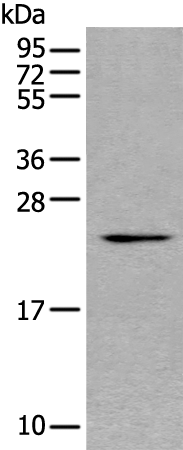
| WB | 1/200-1/1000 | Human,Mouse,Rat |
| IF | 咨询技术 | Human,Mouse,Rat |
| IHC | 咨询技术 | Human,Mouse,Rat |
| ICC | 技术咨询 | Human,Mouse,Rat |
| FCM | 咨询技术 | Human,Mouse,Rat |
| Elisa | 1/2000-1/5000 | Human,Mouse,Rat |
| Aliases | ATF1; ATF2; HSCR3; HFB1-GDNF |
| WB Predicted band size | 24 kDa |
| Host/Isotype | Rabbit IgG |
| Antibody Type | Primary antibody |
| Storage | Store at 4°C short term. Aliquot and store at -20°C long term. Avoid freeze/thaw cycles. |
| Species Reactivity | Human, Mouse, Rat |
| Immunogen | Fusion protein of human GDNF |
| Formulation | Purified antibody in PBS with 0.05% sodium azide and 50% glycerol. |
+ +
以下是关于GDNF抗体的3篇参考文献及其摘要概述:
---
1. **文献名称**:*GDNF Antibodies in Neurodegenerative Diseases: Tools for Therapeutic Approaches*
**作者**:Airaksinen, M.S. et al.
**摘要**:该研究评估了多种GDNF抗体在帕金森病动物模型中的应用,发现特异性抗体能有效检测内源性GDNF表达,并验证其在脑组织中的神经营养作用,为抗体介导的GDNF递送治疗提供依据。
---
2. **文献名称**:*Comparative Analysis of Commercial GDNF Antibodies for Specificity and Sensitivity*
**作者**:Schaar, D.G. & Hyman, C.
**摘要**:通过Western Blot和免疫组化比较了不同来源的GDNF抗体,发现部分抗体存在交叉反应性(如与Artemin蛋白结合),提示选择高特异性抗体对精准检测GDNF至关重要。
---
3. **文献名称**:*GDNF Neutralizing Antibody Attenuates Pain Hypersensitivity in Rodent Models*
**作者**:Bennett, D.L. et al.
**摘要**:研究利用中和性GDNF抗体抑制外周神经损伤模型中的GDNF活性,发现其可显著缓解疼痛超敏反应,表明GDNF信号通路是慢性神经病理性疼痛的潜在治疗靶点。
---
4. **文献名称**:*Technical Challenges in GDNF Detection: Pitfalls of Antibody-Based Assays*
**作者**:Trupp, M. et al.
**摘要**:探讨了GDNF低表达水平导致的检测困难,强调抗体浓度、组织固定方法对结果的影响,建议结合ELISA和免疫荧光进行多方法验证以提高可靠性。
---
以上文献涵盖抗体应用、特异性比较、疾病机制研究及技术挑战,可支持实验设计或文献综述。如需具体文章链接或发表年份,可进一步补充检索条件。
Glial cell line-derived neurotrophic factor (GDNF) is a member of the transforming growth factor-β (TGF-β) superfamily, initially identified for its critical role in promoting the survival and differentiation of dopaminergic neurons. It exerts neuroprotective effects and supports synaptic plasticity, making it a key target in research on Parkinson’s disease, neurodegenerative disorders, and nerve injury repair. GDNF signals through a multi-component receptor complex, binding preferentially to GDNF family receptor α1 (GFRα1), which activates the RET tyrosine kinase to trigger downstream pathways like PI3K/AKT and MAPK/ERK, regulating cell survival, proliferation, and differentiation.
GDNF antibodies are essential tools for detecting and modulating GDNF activity in both research and therapeutic contexts. In research, they are used in techniques such as Western blotting, immunohistochemistry, and ELISA to quantify GDNF expression, map its distribution in tissues, or block its function in mechanistic studies. Therapeutically, neutralizing GDNF antibodies are explored to inhibit aberrant GDNF signaling in cancers (e.g., neuroblastoma, prostate cancer) where overexpression drives tumor progression and metastasis. Conversely, antibody-based delivery systems are also investigated to enhance GDNF bioavailability in neurological therapies. Challenges include ensuring antibody specificity and optimizing delivery methods to cross the blood-brain barrier. Overall, GDNF antibodies bridge basic research and clinical innovation, offering insights into disease mechanisms and potential treatment strategies.
×